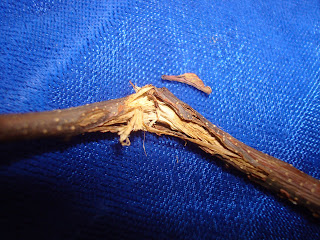By: Jean Burridge,
Certified Illinois Arborist, and U of I Plant Clinic Volunteer
Certified Illinois Arborist, and U of I Plant Clinic Volunteer
This has been an emergence year for periodical cicada in much of the southern part of the state. (See Phil Nixon's article in Home, Yard, and Garden Pest Newsletter, Issue 2). After thirteen years of subterranean existence, adults surfaced in late spring. Males sang, females listened; eggs were laid. Female cicadas possess a saw-like ovipositor, which they use to cut slits in twigs and small branches. They then insert their eggs into the wounds. The eggs will hatch in late summer, and the nymphs will drop to the ground and disappear into the earth. By August, an aggregation of insects so large and impressive that it has its own name (like Ann Arbor) will exist only inside the twigs of trees. Magicicada, indeed.
This feat of compression is not without cost. If you live in an area that is home to the brood, you may be seeing damage to trees, shrubs, or even perennials. Large trees look bedraggled – a bad hair year about sums it up. Trees that have been badly hit will have a fringe of dangling twigs. Weakened branches may snap immediately, or hang on until wind or ice loading finishes them off.
The loss of apical dominance in an injured branch results in bushy unbalanced growth, as a host of lateral buds vie to replace the lost leader. The damage – broken branches, oviposition scars and aberrant growth – will be visible for years.
It is too late to protect trees at this time. Native trees have co-evolved with cicadas – large trees usually grow out of their injuries and are not permanently harmed. Anything you can do to relieve stress would be helpful; water during dry spells and fertilize in the fall.
Small trees or shrubs can succumb to this death of a thousand cuts; they may need to be replaced. If an emergence is anticipated, it is best to delay planting new trees until ovipositon has ceased.
Small trees or shrubs can succumb to this death of a thousand cuts; they may need to be replaced. If an emergence is anticipated, it is best to delay planting new trees until ovipositon has ceased.
Biologists suspect that periodical cicadas may have evolved to emerge on a thirteen or seventeen year cycle, in part because these are prime numbers. (Such protracted phenomena are very difficult for biochronologists to isolate – see Zivkovik. Mathematicians have modeled cicada broods – see Lehmann-Ziebarth et al.) Cicadas on this schedule can evade their predators, whose reproductive cycle cannot track them effectively. Animals who grew fat on cicadas have offspring who partake of no such abundance. When the brood reappears, there are no extra mouths to greet it. There is one animal, however – Homo sapiens - that is fully capable of exploiting a thirteen year interval. The Great Southern Brood will rise from the earth in 2024; be prepared….
Lehmann-Ziebarth, Nicholas , et al. “Evolution of Periodicity in Periodical Cicadas”. Ecology 86 (12) 2005. pp 3200-3211. http://www.math.wisc.edu/~milewski/Paul_Milewski,_Professor_of_Mathematics/Publications_files/cicadas.pdf Web. 7/14/2011.
Nixon, Phil. “Periodical Cicada”. Home, Yard and Garden Pest Report Issue 2, May 2 2011. http://hyg.ipm.illinois.edu/article.php?id=263 Web. 7/14/2011
Zivkovik, Bora. “Centuries to Solve the Secrets of Cicadas”. http:www.scientificamerican.com/blog/post.cfm?id=too-hard-for-science-bora-zivkovil-2011-05-16. Web. 7/14/2011






No comments:
Post a Comment
Note: Only a member of this blog may post a comment.